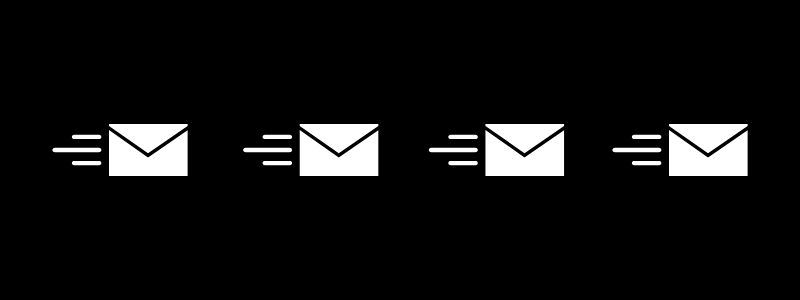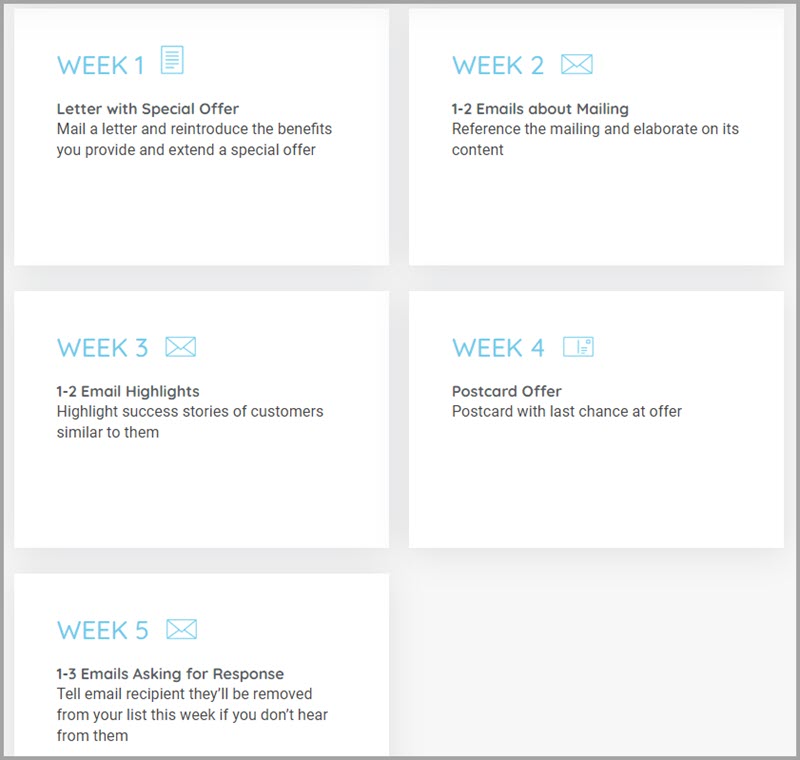
I often hear from dental lab industry marketers that they want to “test direct mail marketing” and my first response is to recommend multi-touch direct mail campaigns.
What surprises me is how often marketers that are new to direct mail are thinking they’ll send out a single touch of say, 500 pieces to evaluate “whether direct mail works” for them. If it works, great. If not, they’ll plan to move on to something else.
That’s a shame because like so many aspects of business, especially with dental laboratories it often takes more than one send to generate the desired response.
And drawing broad conclusions such as “direct mail doesn’t work” from just one mailing results in plenty of missed opportunities.
Experienced direct mailers understand the need to use multiple touches to maximize the impact of a campaign, and are planning to implement a consistent testing strategy across each touch.
They know direct mail “works”. It’s a matter of finding the right audience, offer and creative.
You’d Fire A Salesperson That Gives Up After One Touch

Think about it this way: If you’re a salesperson, would you make one phone call, leave a message, and if you don’t get a call back just give up on that prospect?
Of course not. You’d probably try to contact that prospect a few more times because it often takes more than one attempt to make a sale. It’s always been that way and always will be.
Multi-touch marketing is at the core of the way modern business is conducted. Direct mail works the same way.
You don’t often see pattern of “single touch” in other forms of media. Whether running traditional offline ads in magazines or on TV or engaging with prospects online, do you run just one ad and call it a day?
No way!
Think about how long ads on a topic you’ve researched online follow you around — on Facebook, websites, and apps you use — for days, if not weeks.
So why should direct mail be any different?
It’s not, and you don’t need to take my word for it. According to Mike Schultz, President of the RAIN Group, says it can take an “average of 8 touches to get an initial meeting (or other conversion) with a new prospect” and in some cases it can take more.
Multi-touch marketing: Communicate with hot prospects again and again

I guess one silver lining is that because so many organizations give up way too soon, you can benefit from your competitor’s mistakes!
When you consider how direct mail pairs excellently with other forms of media — both online and offline — an integrated campaign can deliver results far more impressive than with one type of media alone.
In fact, many DentalLabSupport.com clients use direct mail in conjunction with their email campaigns. I consistently hear from our clients that there’s a combined lift when both are used.
Properly timed, email supports direct marketing campaigns and direct mail boosts email response rates. Consider these research findings:
According to a 2019 USPS white paper, The Future of Direct Mail Is Here and It’s Dynamic, 60 percent of marketers surveyed said that combining digital and direct mail increased ROI — with 68 percent reporting increased website visits.
A Target Marketing “Media Usage Survey” described a controlled study in which a print-only campaign produced a 6 percent response rate while the same campaign distributed through both print and email lifted that response rate by more than 25 percent — to 7.6 percent.
A DentalLabSupport Marketing survey reported that more than half of all small businesses use three or more marketing channels.
And with today’s automated tools, marketers can more quickly take action based on how prospects respond online — whether visiting a website, clicking a link in an email, or interacting through social media — using that information to retarget prospects with personalized direct mail that can be sent instantly to a printer/mailer for processing.
Multi-touch direct mail for the full buyer’s journey

How can you best use this integration of multiple communication channels?
One way is through pre-defined workflows designed to meet specific goals such as building awareness, generating leads, nurturing leads, promoting events, and more. But even using direct mail alone delivers better results when you don’t give up too soon.
Here’s a sample email/direct mail campaign designed to reactivate cold or dead leads. Which do you think has a better chance of energizing an old lead – a single direct mail or this multi-touch marketing campaign?

Whether you combine other channels or not, it’s important to understand that a successful multi-touch direct mail campaign requires more than simply sending out several mailings one after the other. When each is strategically timed to influence prospects along the buying journey, you can enjoy more successful results.
Attribution Makes Direct Mail Click

You see, what makes direct mail an exceptional offline media channel is that you get precise attribution you don’t get with mass media such as print ads or TV.
By using automatically generated, personalized URLs (pURLs), you can track online response (or non-response) across each “mail drop” or touch of a multi-touch direct mail campaign.. By using pURLs as the “bridge” between your mailings and the online experience, you get both the impact and high response of direct mail and the tracking and analytics you expect from digital marketing channels.
An example campaign: How multi-touch mailings multiply results
Here’s an example that shows how multiple mailings might work. Let’s assume that you sell an e-learning solution offering home-based tutoring in a wide variety of skills for students in grades K-12.
You might start a campaign with an initial sequence of three different direct mail packages (which could be sent along with email) each focusing on a different benefit — perhaps based on skills taught, age range, ease of use, etc.

A response to any of the three mailings would trigger another sequence of the multi-touch direct mail based on that specific benefit.
If there’s no response to the first mailing, you send another, and then another. If there’s no response after three mailings, you might give up on that prospect (for now, anyway).
If you do get a response, another sequence designed around the benefit that drove that response begins. These mailings might include a higher commitment offer — for example, a sales call. If there’s no response, that specific sequence might continue for another two or three mailings.
Here’s how these multi-touch marketing sequences look. First, you’d have three initial emails designed to segment prospects into specific follow-up mailing sequences:
Initial flow
No response Response
Offer A1 Offer A2 Responder Flow X
Offer A2 Offer A3 Responder Flow Y
Offer A3 Stop mailing for now Responder Flow Z
Then, each follow-up sequence can be structured in a similar way – but customized to the first offer the prospect found relevant:
Responder Flow X No response Response
Offer X1 Offer X2 Sales call
Offer X2 Offer X3 Sales call
Offer X3 Stop mailing for now Sales call
Responder Flow Y No response Response
Offer Y1 Offer Y2 Sales call
Offer Y2 Offer Y3 Sales call
Offer Y3 Stop mailing for now Sales call
Offer Y1 Offer Y2 Sales call
Offer Y2 Offer Y3 Sales call
Offer Y3 Stop mailing for now Sales call
Responder Flow Z No response Response
Offer Z1 Offer Z2 Sales call
Offer Z2 Offer Z3 Sales call
Offer Z3 Stop mailing for now Sales call
You can intersperse email into this flow, allow for special mailings to be sent if a prospect visits your website, a specific web page, or downloads a specific resource. Yes, this seems as if this flow would be complex to set up, but today’s automated direct mail platforms integrate with marketing automation tools to make this exceedingly easy and affordable.
Even just a few years ago, a multi-touch campaign like this would be far too complex and costly to execute. For example, sending a direct mail piece within a few hours of a visit to your website might mean sending only a few mailings per day. The fixed costs of setting up printing and mailing — which are the same whether sending 10 or 10,000 pieces — would have been prohibitive.
So don’t give up – at least not too soon. Because if at first you don’t succeed, that next mailing could be the one that triggers a profitable sale.
Automated segmentation for multi-touch marketing
Better yet, today’s direct mail tools are automated to segment your audience based on their response (or non-response) and send subsequent direct mail pieces with specific creative customized for each segment.
Each part of a multi-touch direct mail campaign can be scheduled to target these precise segments through simple campaign wizards — without the need to manually tabulate responses and build lists for each mailing.
For example, if you send a direct mail postcard and get a response to a specific offer, you may send another direct mail piece, perhaps a thank you letter, a week later with another offer.
If you don’t receive a response, you might send another postcard, perhaps highlighting a different benefit of the same offer.
You can even test various approaches as your campaign continues – so you can gain even more insights into what works and what doesn’t. For more information on best practices for testing, review my latest post here
DentalLabSupport.com
Offer Z1 Offer Z2 Sales call
Offer Z2 Offer Z3 Sales call
Offer Z3 Stop mailing for now Sales call
You can intersperse email into this flow, allow for special mailings to be sent if a prospect visits your website, a specific web page, or downloads a specific resource. Yes, this seems as if this flow would be complex to set up, but today’s automated direct mail platforms integrate with marketing automation tools to make this exceedingly easy and affordable.
Even just a few years ago, a multi-touch campaign like this would be far too complex and costly to execute. For example, sending a direct mail piece within a few hours of a visit to your website might mean sending only a few mailings per day. The fixed costs of setting up printing and mailing — which are the same whether sending 10 or 10,000 pieces — would have been prohibitive.
So don’t give up – at least not too soon. Because if at first you don’t succeed, that next mailing could be the one that triggers a profitable sale.
Automated segmentation for multi-touch marketing

Better yet, today’s direct mail tools are automated to segment your audience based on their response (or non-response) and send subsequent direct mail pieces with specific creative customized for each segment.
Each part of a multi-touch direct mail campaign can be scheduled to target these precise segments through simple campaign wizards — without the need to manually tabulate responses and build lists for each mailing.
For example, if you send a direct mail postcard and get a response to a specific offer, you may send another direct mail piece, perhaps a thank you letter, a week later with another offer.
If you don’t receive a response, you might send another postcard, perhaps highlighting a different benefit of the same offer.
You can even test various approaches as your campaign continues – so you can gain even more insights into what works and what doesn’t. For more information on best practices for testing, review my latest post here
DentalLabSupport.com
Sponsored By:
